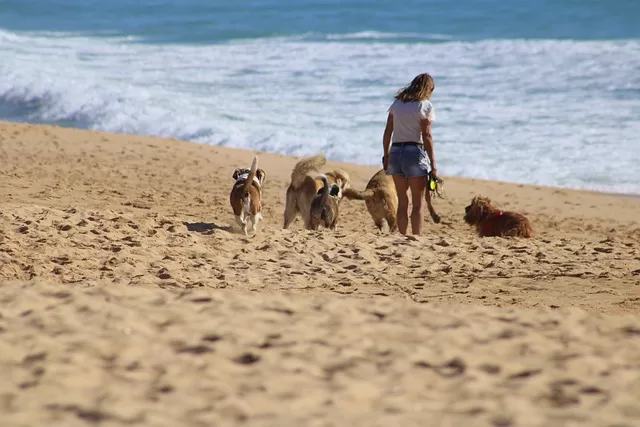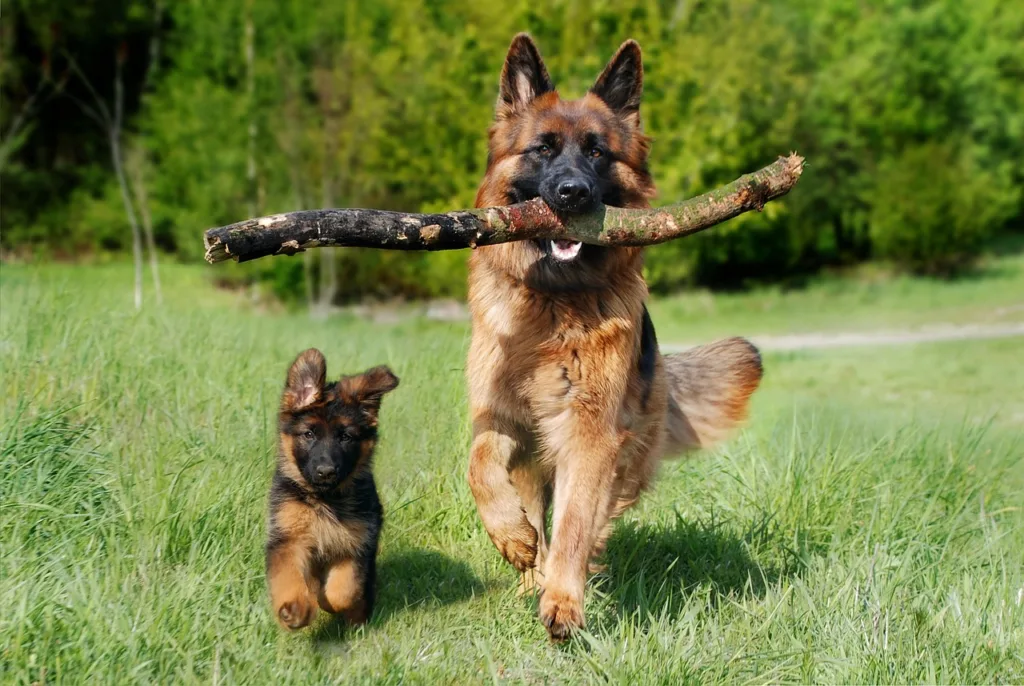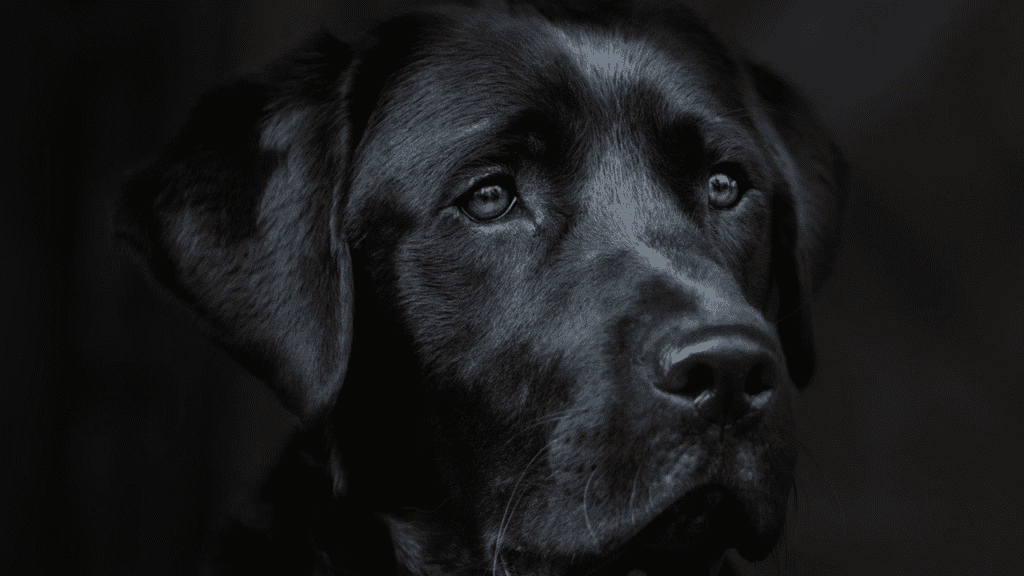Understanding Our Dog's Fear of Thunderstorms.
If Your Dog is terrified of thunder, he/she is not alone, I don’t like it myself. Our doggie’s thunderstorm phobia is a prevalent issue that affects a significant portion of the dog population.
Let’s face it, a lot of us don’t like Thunderstorms, with their unpredictable loud noises and sudden flashes of lightning, they can induce a range of fear responses into the toughest of humans, so why should our dogs be immune.
The fear reaction our dogs have is often known as thunderstorm anxiety and it tends to manifest through various symptoms.
Common signs include trembling, hiding, panting, drooling, pacing, and excessive barking. In more severe cases, dogs might display destructive behaviours or even attempt to escape the perceived danger, possibly in some situations, risking injury.
Understanding and addressing this fear is crucial for the well-being of our canine companions.
When a dog is in a state of high anxiety, their overall quality of life is diminished. Prolonged stress can lead to long-term health issues, both physical and psychological.
Therefore, it is essential for pet owners to recognize the signs of thunderstorm phobia and take steps to alleviate their dogs’ distress.
By doing so, they not only improve their pets’ immediate comfort but also contribute to their long-term health and happiness.
Historical Evidence of Thunderstorm Fear in Dogs.
The phenomenon of dogs exhibiting fear during thunderstorms is not a modern occurrence but one that has been documented across various cultures and eras.
Historical accounts and ancient texts provide ample evidence that dogs have been afraid of thunderstorms for centuries.
In ancient Greece, Aristotle referenced the distress of animals, including dogs, during storms in his works.
Similarly, Roman literature, including writings by Pliny the Elder, documented observations of canine anxiety provoked by thunder and lightning.
Folklore from different cultures also reflects this behavioural pattern.
For instance, in Norse mythology, thunderstorms were attributed to the god Thor, and it was believed that dogs could sense his presence, leading to their heightened fear.
Similarly, Native American folklore often depicted animals, particularly dogs, as being highly sensitive to natural phenomena, including thunderstorms.
Early veterinary observations further substantiate these historical accounts. Veterinary texts from the 18th and 19th centuries describe various methods employed by pet owners to soothe their dogs during thunderstorms.
These methods included herbal remedies, physical comfort, and, in some cases, the use of early forms of sedatives. Such documentation underscores the long-standing recognition of this issue and the efforts to address it.
Interestingly, this fear has been noted across different cultures and time periods, indicating that it is a widespread and persistent issue.
From ancient civilizations to modern times, the recurring theme of dogs’ fear of thunderstorms suggests an intrinsic behavioural response that has transcended generations.
Understanding this historical context enriches our comprehension of the issue and underscores the importance of continuing to seek effective solutions to alleviate this fear in our canine companions.
Explanations I’ve Been Reading About On Thunderstorm Anxiety in Dogs.
Understanding why thunderstorms provoke anxiety in dogs involves delving into several scientific explanations.
One predominant theory attributes this fear to the loud noise produced by thunder. Dogs possess a more acute sense of hearing compared to humans, allowing them to detect sounds at higher frequencies and greater distances.
The unexpected and intense nature of thunderclaps can be overwhelming, often triggering a fight-or-flight response in dogs.
Another significant factor is the sudden change in atmospheric pressure that accompanies thunderstorms.
Dogs are highly sensitive to such environmental changes, which can cause discomfort and confusion. This heightened sensitivity might contribute to their anxiety during storms, as the rapid shifts in pressure can be perceived as a threat.
Additionally, static electricity generated during a thunderstorm can play a crucial role in exacerbating a dog’s fear.
Some studies suggest that dogs can feel the build-up of static electricity in their fur, causing discomfort and agitation.
Dr. Nicholas Dodman, a world renowned animal behaviourist, has explored this phenomenon, noting that some dogs may even seek out grounded areas, such as bathtubs, to alleviate the discomfort caused by static charges.
It’s worth looking him up on your browser as he seems like a very clever person.
Research also indicates that dogs may associate the sensory experiences of thunderstorms with previous traumatic events.
This associative learning can result in a conditioned fear response, where the mere sound of thunder or the sight of lightning triggers anxiety, even if the initial cause of the fear is not present.
So, What Are The Factors With Our Dogs Fear Of Thunder.
From what I’ve been able to find, understanding a dog’s fear of thunderstorms requires delving into the behavioural and psychological factors that contribute to this anxiety.
Genetics can even supposedly play a role, although I struggle with that idea. Some out there are saying that certain breeds are apparently predisposed to heightened sensitivity to loud noises, including thunderstorms.
For instance, herding breeds like Border Collies and Australian Shepherds often exhibit more huge reactions to thunderstorms, which is true from my experience with Border Collies at least. It’s just how can they suggest that it’s an inherited component to their fear? There’s plenty of humans that are not comfortable with Thunder as well.
This apparent genetic predisposition can then I guess be compounded by early life experiences.
Puppies that are exposed to thunderstorms in a negative context may develop a lasting aversion, whereas positive or neutral experiences can help mitigate this fear.
In addition to genetics and early experiences, the reaction of an owner during a storm can significantly influence a dog’s behaviour and that definitely makes sense to me.
Dogs are highly attuned to our emotions and can easily pick up on their pet parent’s anxiety or fear associated with Thunder.
When we react in a big way to a thunderstorm with visible stress or if we go over the top a bit with attempting to overly comfort our dog, it can inadvertently reinforce the dog’s fear.
Conversely, maintaining a calm demeanour can help signal to the dog that there is no real threat, thereby reducing anxiety levels.
Another critical aspect is the interplay between a dog’s natural instincts and learned behaviours.
What is very interesting with this subject is that there’s plenty of information to suggest that Dogs are inherently sensitive to changes in barometric pressure, static electricity, and loud noises all common during thunderstorms.
These environmental cues can trigger an instinctual fear response.
However, through consistent training and desensitisation techniques, it is possible to alter the learned behaviours associated with this instinctual fear.
Methods such as counter-conditioning and gradual exposure can help retrain a dog’s reaction to storms, making them less fearful over time.
Ultimately, understanding the complex nature of our dogs is the goal I think.
Let’s try to ensure their early life experiences during thunderstorms are nice and calm. I’m now thinking that this is crucial in addressing a doggies fear of thunderstorms.
By recognizing these factors, we can better tailor our approaches to alleviate their anxiety, fostering a more serene environment during storms.
What’s also interesting is that certain physical conditions of our dogs can apparently exacerbate anxiety during storms.
For instance, dogs suffering from chronic pain or arthritis may experience heightened sensitivity to meteorological changes, leading to increased discomfort and anxiety. Which makes me think that our dog might feel more vulnerable if they’ve got a health issue?
I’ve also read that some Vets suggest that dogs with auditory sensitivities (super duper dog hearing) might also be more prone to experiencing fear during thunderstorms due to the overwhelming nature of sudden loud noises.
There’s also stuff on the web about Neurological factors also playing a significant role in a dog’s response to thunderstorms.
They suggest that Dogs that have a history of neurological disorders may exhibit increased anxiety during storms. I think that would extend to any living being as well though, so not sure why that would be specific to our dogs but data is data though I guess.
There was some very interesting info I found about how barometric pressure changes that accompany thunderstorms can trigger neurological responses in some dogs.
This heightened state of alertness can manifest as trembling, excessive panting, or even destructive behaviour.
Vets are often emphasising the importance of a multi-faceted approach to managing a dog’s fear of thunderstorms, which I think makes total sense. They will look at addressing any underlying medical conditions that could be contributing to the anxiety.
It’s a good reason to make sure we keep up with regular veterinary check-ups. There’s a lot we don’t know about our dogs, so it’s essential to give our Vets the opportunity to identify and manage these conditions effectively with us.
By letting our Vets have the time with our dog to gain a deeper understanding of the medical and neurological factors at play, they can help us better tailor strategies to alleviate our dog’s fear. Thus ensuring a more comfortable and less stressful experience during thunderstorms for our fur babies.
Creating a Safe Space for Your Dog During A Thunderstorm.
One of the most effective strategies to help alleviate your dog’s fear of thunderstorms is to create a designated safe space within your home.
This area should be a place where your dog feels secure, comfortable, and protected from the loud noises and flashes of lightning that accompany thunderstorms.
A designated safe space can significantly reduce your dog’s anxiety and stress during these unsettling weather events.
Start by identifying a quiet and secluded area in your home, such as a basement, bathroom, or a small room with few windows.
This space should be easily accessible to your dog at all times.
Equip the area with comforting items that are familiar to your dog, such as their favourite blankets, toys, and bedding.
These items can provide a sense of normalcy and security, helping to calm your dog during the storm.
Additionally, consider adding soundproofing elements to the safe space to minimize the impact of thunderous noises.
Heavy curtains or soundproof panels can help reduce the intensity of the sounds from outside. Have a look on Amazon and Temu, there’s plenty of stuff on these sites. I quite like the look of these packs of Acoustic Foam Panels you can get from Temu. You can normally get sound suppression batts from your local hardware store too.
Playing calming music or white noise in the background can also drown out the thunder, providing a more serene environment for your dog.
Some pet parents have found that using a white noise machine or a noisy fan or fan heater can be effective in masking the disruptive sounds of a thunderstorm.
I agree with how people are saying that it’s important to ensure that any safe space you set-up for your dog, remains a positive environment for your dog all the time. That makes a lot of sense, so that way they know in that particular spot, only good or nice things happen.
Avoid using it as a place for punishment or confinement would naturally mess up the whole idea, as this could create negative associations.
We just need to encourage our dog to enter the space voluntarily by placing treats or their favourite toys inside. The goal is to make this area a sanctuary where your doggie can retreat and feel secure during thunderstorms.
By thoughtfully creating a safe and comforting environment, you can help your dog manage their fear of thunderstorms more effectively.
This proactive approach not only alleviates their immediate anxiety but also contributes to their overall well-being and sense of security in your home.
15 Tips I Personally Like To Help Our Dogs Overcome Thunderstorm Fear.
1. Create a Safe Space: Designate a quiet, comfortable area in your home where your dog can retreat during storms. This safe space can help your dog feel secure and reduce anxiety.
2. Use Calming Music: Playing soothing music or white noise can mask the sound of thunder and create a calming environment for your dog.
3. Invest in Anxiety Wraps: Anxiety wraps, such as Thundershirts, apply gentle pressure to your dog’s body, which can have a calming effect similar to swaddling a baby.
4. Provide Distractions: Engage your dog with toys, treats, or interactive games to divert their attention away from the storm.
5. Offer Comfort: Comforting your dog with gentle petting and a calm voice can provide reassurance and help alleviate their fear.
6. Use Pheromone Diffusers: These diffusers release calming pheromones that can help reduce your dog’s anxiety during thunderstorms.
7. Desensitisation Training: Gradually expose your dog to the sounds of thunderstorms in a controlled environment to help them become accustomed to the noise.
8. Counter-conditioning: Pair the sound of thunder with positive experiences, such as treats or playtime, to help your dog associate the noise with something pleasant.
9. Keep Blinds Closed: Closing blinds or curtains can help block out the sight of lightning flashes, which can contribute to your dog’s fear.
10. Stay Calm: Dogs often pick up on their owner’s emotions. Remaining calm and composed can help your dog feel more secure during a storm.
11. Use a Crate: If your dog is crate-trained, their crate can serve as a safe and secure space during a storm.
12. Try Natural Remedies: Herbal supplements and CBD oil are natural options that can help calm your dog’s anxiety. Consult your veterinarian before use.
13. Consult a Veterinarian: If your dog’s fear is severe, a veterinarian can recommend medications or other treatments to help manage their anxiety.
14. Seek Professional Help: An animal behaviourist can provide specialized training and techniques to address your dog’s thunderstorm fear.
15. Practice Patience: Overcoming thunderstorm anxiety is a gradual process. Consistently applying these tips with patience and understanding will help your dog feel more secure over time.
Patience & Persistence When Helping Your Dog Get Over Thunder.
Addressing your dog’s fear of thunderstorms requires a substantial investment of patience and persistence.
It’s essential to recognize that overcoming this fear is a gradual process, one that demands consistent effort and a deep understanding of your pet’s unique needs.
By maintaining a calm and supportive environment during thunderstorms, you can help mitigate your dog’s anxiety and build their confidence over time.
Consistency is key folks. Regularly applying the techniques and strategies discussed whether it be desensitisation exercises, creating a safe space, or using calming aids reinforces positive behaviour and helps your dog gradually acclimate to the sounds and sensations of a storm.
It’s just so important to be patient, as progress may be slow, but each small step forward is a victory worth celebrating.
For some dogs, professional help from a veterinarian or a certified animal behaviourist may be necessary. These professionals can offer tailored advice and interventions that can make a significant difference in managing your dog’s fear of thunderstorms.
Don’t hesitate to reach out for expert guidance if your efforts at home don’t seem to be making sufficient progress.
Understanding and addressing your dog’s fear of thunderstorms can greatly enhance their quality of life.
As a pet parent, our role is to provide comfort and security, fostering an environment where your dog feels safe even during the most unsettling weather conditions.
By doing so, we not only alleviate their anxiety but also strengthen the bond we share.
Remember, the journey to help your dog overcome their fear may be challenging, but the rewards of seeing your pet more relaxed and confident are well worth the effort. Stay committed, be gentle, and celebrate the small milestones along the way.











